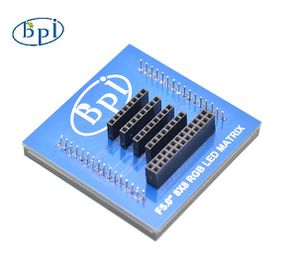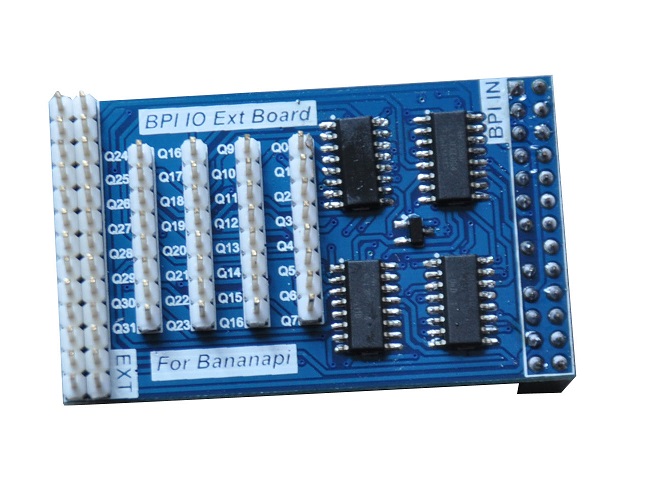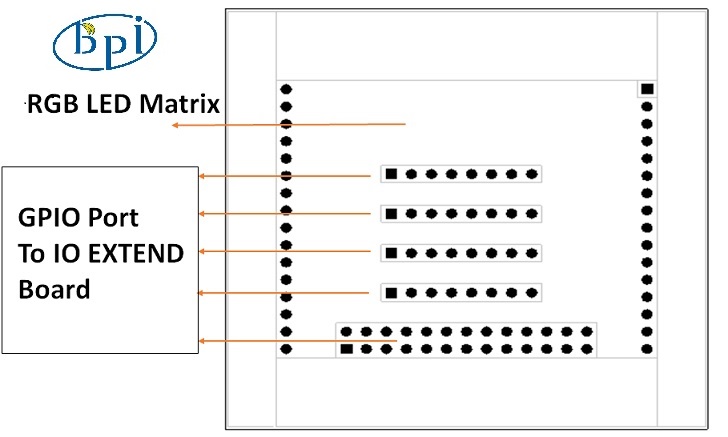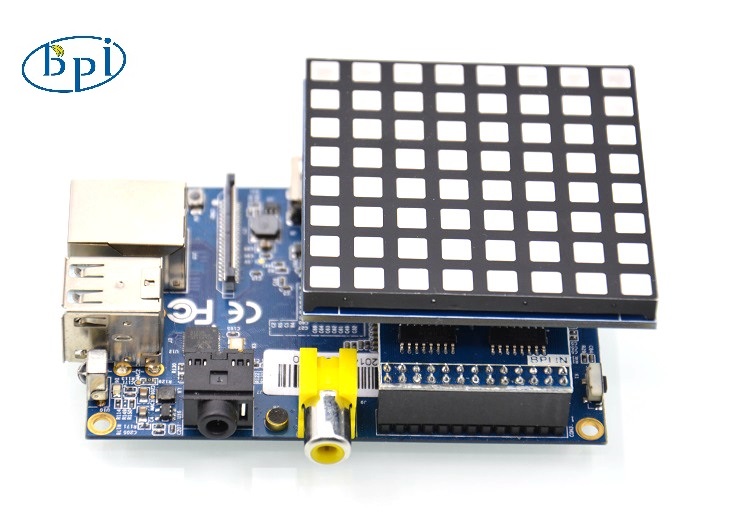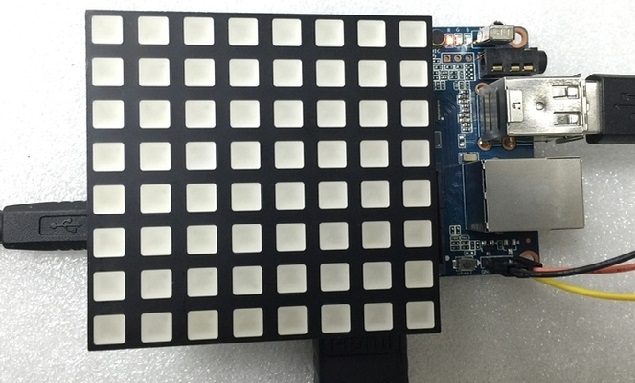Difference between revisions of "BPI RGB LED Matrix Expansion Module"
(→How to use on BPI-M3) |
|||
| (One intermediate revision by the same user not shown) | |||
| Line 51: | Line 51: | ||
For the Banana Pi ,just Insert these two module like the picture Below | For the Banana Pi ,just Insert these two module like the picture Below | ||
| − | + | [[File:8x8_RGB_LED_Matrix_7.JPG]] | |
==How to use on BPI-M3== | ==How to use on BPI-M3== | ||
| Line 59: | Line 59: | ||
Version: 1.0 HDMI | Version: 1.0 HDMI | ||
| − | + | [[File:ON_m3.jpg]] | |
Step 1: Download WiringPI | Step 1: Download WiringPI | ||
Latest revision as of 18:58, 16 May 2018
Contents
[hide]Produce Overview
The Matrix LED module is specifically designed for Banana Pi. The module with 8X8 Matrix LED. User can custom display content through programming. Pay attention, the module do not include driver board. You have to cooperate with Infinity cascade IO expand module
Produce Features
- 1. Full color RGB
- 2. Square LED point source
- 3. Ultrathin
- 4. Plug and Play
- 5. No wire needed
Port
need work with IO extend module.
Banana Pi connection port,also can use on raspberry pi.
5.Product Parameters
- 1. Dot Size: 5.0mm
- 2. Pixel Array: 8×8
- 3. Luminous Intensity: 40mcd
- 4. Package Dimension: 60mm×60mm
- 5. Reverse Voltage(Max): 5V
- 6. Forward Current(Max): 25mA
- 7. Peak Forward Current(Max): 100mA
- 8. Power Dissipation(Max): 100mW
- 9. Operating Temperature(Max):-35~+85℃
- 10. Storage Temperature(Max): -35~+85℃
- 11. Lead Solder Temperature(Max): 260℃ for 5 seconds
Typical Application
- 1. Scroll the display
- 2. LOGO display
- 3. Dynamic signage
- 1.Product Specification:**
How to use
How to use on BPI-M1
For the Banana Pi ,just Insert these two module like the picture Below
How to use on BPI-M3
OS: BPI-M3 Ubuntu15.10 (Kernel3.4)
Version: 1.0 HDMI
Step 1: Download WiringPI
$ git clone https://github.com/BPI-SINOVOIP/BPI-WiringPi.git1 -b BPI_M3 $ cd BPI-WiringPi $ chmod +x ./build $ sudo ./build
Step 2 : Copy smaple code to Blue_RGB8*8.c file
$ sudo vi Blue_RGB8*8.c
Step 3 : Compile Blue_RGB8*8.c
$ gcc -o Blue_RGB8*8 Blue_RGB8*8.c -l wiringPi
Step 4: Run Blue_RGB8*8
$ sudo ./Blue_RGB8*8
- youtube Video Demo how to install hardware:https://www.youtube.com/watch?v=K6mRB_CtOlI&feature=youtu.be
- youtube Video Demo for display : https://www.youtube.com/watch?v=ynxjzZiSGDo
Sample Code:
#include <stdio.h> #include <wiringPi.h> #include <sr595.h>
#define SPACE { \
{0, 0, 0, 0, 0, 0, 0, 0}, \
{0, 0, 0, 0, 0, 0, 0, 0}, \
{0, 0, 0, 0, 0, 0, 0, 0}, \
{0, 0, 0, 0, 0, 0, 0, 0}, \
{0, 0, 0, 0, 0, 0, 0, 0}, \
{0, 0, 0, 0, 0, 0, 0, 0}, \
{0, 0, 0, 0, 0, 0, 0, 0}, \
{0, 0, 0, 0, 0, 0, 0, 0} \
}
#define FULL { \
{1, 1, 1, 1, 1, 1, 1, 1}, \
{1, 1, 1, 1, 1, 1, 1, 1}, \
{1, 1, 1, 1, 1, 1, 1, 1}, \
{1, 1, 1, 1, 1, 1, 1, 1}, \
{1, 1, 1, 1, 1, 1, 1, 1}, \
{1, 1, 1, 1, 1, 1, 1, 1}, \
{1, 1, 1, 1, 1, 1, 1, 1}, \
{1, 1, 1, 1, 1, 1, 1, 1} \
}
#define H { \
{0, 1, 0, 0, 0, 0, 1, 0}, \
{0, 1, 0, 0, 0, 0, 1, 0}, \
{0, 1, 0, 0, 0, 0, 1, 0}, \
{0, 1, 0, 0, 0, 0, 1, 0}, \
{0, 1, 1, 1, 1, 1, 1, 0}, \
{0, 1, 0, 0, 0, 0, 1, 0}, \
{0, 1, 0, 0, 0, 0, 1, 0}, \
{0, 1, 0, 0, 0, 0, 1, 0} \
}
#define E { \
{0, 1, 1, 1, 1, 1, 1, 0}, \
{0, 1, 0, 0, 0, 0, 0, 0}, \
{0, 1, 0, 0, 0, 0, 0, 0}, \
{0, 1, 1, 1, 1, 1, 1, 0}, \
{0, 1, 0, 0, 0, 0, 0, 0}, \
{0, 1, 0, 0, 0, 0, 0, 0}, \
{0, 1, 0, 0, 0, 0, 0, 0}, \
{0, 1, 1, 1, 1, 1, 1, 0} \
}
#define L { \
{0, 1, 0, 0, 0, 0, 0, 0}, \
{0, 1, 0, 0, 0, 0, 0, 0}, \
{0, 1, 0, 0, 0, 0, 0, 0}, \
{0, 1, 0, 0, 0, 0, 0, 0}, \
{0, 1, 0, 0, 0, 0, 0, 0}, \
{0, 1, 0, 0, 0, 0, 0, 0}, \
{0, 1, 0, 0, 0, 0, 0, 0}, \
{0, 1, 1, 1, 1, 1, 1, 0} \
}
#define O { \
{0, 0, 0, 1, 1, 0, 0, 0}, \
{0, 0, 1, 0, 0, 1, 0, 0}, \
{0, 1, 0, 0, 0, 0, 1, 0}, \
{0, 1, 0, 0, 0, 0, 1, 0}, \
{0, 1, 0, 0, 0, 0, 1, 0}, \
{0, 1, 0, 0, 0, 0, 1, 0}, \
{0, 0, 1, 0, 0, 1, 0, 0}, \
{0, 0, 0, 1, 1, 0, 0, 0} \
}
#define Smile { \
{0, 0, 1, 1, 1, 1, 0, 0}, \
{0, 1, 0, 0, 0, 0, 1, 0}, \
{1, 0, 1, 0, 0, 1, 0, 1}, \
{1, 0, 0, 0, 0, 0, 0, 1}, \
{1, 0, 1, 0, 0, 1, 0, 1}, \
{1, 0, 0, 1, 1, 0, 0, 1}, \
{0, 1, 0, 0, 0, 0, 1, 0}, \
{0, 0, 1, 1, 1, 1, 0, 0} \
}
#define Line { \
{1, 0, 0, 0, 0, 0, 0, 0}, \
{0, 1, 0, 0, 0, 0, 0, 0}, \
{0, 0, 1, 0, 0, 0, 0, 0}, \
{0, 0, 0, 1, 0, 0, 0, 0}, \
{0, 0, 0, 0, 1, 0, 0, 0}, \
{0, 0, 0, 0, 0, 1, 0, 0}, \
{0, 0, 0, 0, 0, 0, 1, 0}, \
{0, 0, 0, 0, 0, 0, 0, 1}, \
}
int RowRed[8]={116,117,118,119,120,121,122,123};
int RowGreen[8]={108,109,110,111,112,113,114,115};
int RowBlue[8]={100,101,102,103,104,105,106,107};
int Column[8]={124,125,126,127,128,129,130,131};
void MatrixSetup()
{
int j;
for(j = 0; j < 32; j++)
{
pinMode(100 + j, OUTPUT);
}
for(j = 0; j < 8; j++)
{
digitalWrite(100 + j, 1);
}
for(j = 0; j < 8; j++)
{
digitalWrite(116 + j, 1);
}
for(j = 0; j < 8; j++)
{
digitalWrite(108 + j, 1);
}
}
void Clear()
{
int i;
for(i=0;i<8;i++)
{
digitalWrite(RowRed[i],1);
digitalWrite(RowGreen[i],1);
digitalWrite(RowBlue[i],1);
digitalWrite(Column[i],0);
}
}
int main(int argc, char *argv[])
{
int column, row, thisPixel;
long long k;
wiringPiSetup();
sr595Setup(100, 32, 12, 14, 10);
MatrixSetup();
int matrix[8][8]= Smile ;
while(1)
{
Clear();
for(column=0;column<8;column++)
{
digitalWrite(Column[column],1);
for(row=0;row<8;row++)
{
if(matrix[column][row] == 1)
digitalWrite(RowBlue[row],0); // Blue color
digitalWrite(RowBlue[row],1); // Blue color
}
digitalWrite(Column[column],0);
}
}
}

